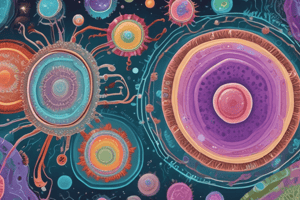Podcast
Questions and Answers
What is the primary component of bacterial cell walls?
What is the primary component of bacterial cell walls?
- Cellulose
- Chitin
- Proteoglycans
- Peptidoglycan (correct)
Which type of virus is characterized by reverse-transcribing RNA into DNA?
Which type of virus is characterized by reverse-transcribing RNA into DNA?
- Retrovirus (correct)
- DNA virus
- Oncovirus
- RNA virus
What is the first line of defense against pathogens in the human body?
What is the first line of defense against pathogens in the human body?
- Innate immunity
- Humoral response
- Adaptive immunity
- Physical barriers (correct)
What type of organism is characterized by obtaining nutrients by feeding on host tissues or fluids?
What type of organism is characterized by obtaining nutrients by feeding on host tissues or fluids?
Which type of bacteria is characterized by a thick peptidoglycan layer in their cell walls?
Which type of bacteria is characterized by a thick peptidoglycan layer in their cell walls?
What is the term for the process by which viruses replicate inside host cells?
What is the term for the process by which viruses replicate inside host cells?
What is the term for the type of immune response that occurs after initial exposure to an antigen?
What is the term for the type of immune response that occurs after initial exposure to an antigen?
Which type of disease is characterized by an overactive immune response?
Which type of disease is characterized by an overactive immune response?
Study Notes
Microbiology
Bacteria
- Characteristics:
- Prokaryotic cells (no nucleus or membrane-bound organelles)
- Cell walls composed of peptidoglycan (also known as murein)
- Can be gram-positive (thick peptidoglycan layer) or gram-negative (thin peptidoglycan layer)
- Types:
- Aerobic (require oxygen) vs. anaerobic (do not require oxygen)
- Autotrophic (produce own food) vs. heterotrophic (obtain food from environment)
- Importance:
- Decomposition and nutrient cycling
- Food production (e.g., yogurt, cheese, bread)
- Human health (e.g., gut microbiome, disease causation)
Virology
- Characteristics:
- Not considered living cells (do not metabolize, grow, or respond to stimuli)
- Composed of genetic material (DNA or RNA) surrounded by a protein coat (capsid)
- Can replicate only inside host cells
- Types:
- DNA viruses (e.g., herpesviruses, adenoviruses)
- RNA viruses (e.g., influenza, HIV)
- Retroviruses (e.g., HIV, which reverse-transcribes RNA into DNA)
- Importance:
- Human disease causation (e.g., common cold, influenza, AIDS)
- Vaccine development
- Cancer research (e.g., oncoviruses)
Immunology
- Immune System:
- First line of defense: physical barriers (skin, mucous membranes)
- Second line of defense: innate immunity (e.g., neutrophils, macrophages)
- Adaptive immunity (acquired through exposure): humoral (antibodies) and cell-mediated responses
- Immune Responses:
- Primary response: initial exposure to antigen
- Secondary response: subsequent exposure to antigen (faster, stronger response)
- Dysfunction:
- Immunodeficiency (e.g., HIV/AIDS)
- Autoimmune disorders (e.g., rheumatoid arthritis, lupus)
- Hypersensitivity reactions (e.g., allergies, anaphylaxis)
Parasitology
- Characteristics:
- Eukaryotic organisms (nucleus and membrane-bound organelles)
- Obtain nutrients by feeding on host tissues or fluids
- Can be extracellular (e.g., tapeworms) or intracellular (e.g., Plasmodium)
- Types:
- Protozoa (e.g., Plasmodium, Giardia)
- Helminths (e.g., tapeworms, hookworms)
- Importance:
- Human disease causation (e.g., malaria, schistosomiasis)
- Zoonotic diseases (transmitted from animals to humans)
- Public health significance in developing countries
Bacteria
- Cell Characteristics:
- Lack of nucleus and membrane-bound organelles (prokaryotic cells)
- Cell walls composed of peptidoglycan (murein)
- Types of Bacteria:
- Aerobic (require oxygen) vs. anaerobic (do not require oxygen)
- Autotrophic (produce own food) vs. heterotrophic (obtain food from environment)
- Gram Staining:
- Gram-positive (thick peptidoglycan layer) vs. gram-negative (thin peptidoglycan layer)
- Importance of Bacteria:
- Decomposition and nutrient cycling
- Food production (e.g., yogurt, cheese, bread)
- Human health (e.g., gut microbiome, disease causation)
Viruses
- Viral Characteristics:
- Not considered living cells (do not metabolize, grow, or respond to stimuli)
- Composed of genetic material (DNA or RNA) surrounded by a protein coat (capsid)
- Can replicate only inside host cells
- Types of Viruses:
- DNA viruses (e.g., herpesviruses, adenoviruses)
- RNA viruses (e.g., influenza, HIV)
- Retroviruses (e.g., HIV, which reverse-transcribes RNA into DNA)
- Importance of Viruses:
- Human disease causation (e.g., common cold, influenza, AIDS)
- Vaccine development
- Cancer research (e.g., oncoviruses)
Immunology
- Immune System:
- First line of defense: physical barriers (skin, mucous membranes)
- Second line of defense: innate immunity (e.g., neutrophils, macrophages)
- Adaptive immunity (acquired through exposure): humoral (antibodies) and cell-mediated responses
- Immune Responses:
- Primary response: initial exposure to antigen
- Secondary response: subsequent exposure to antigen (faster, stronger response)
- Dysfunction of the Immune System:
- Immunodeficiency (e.g., HIV/AIDS)
- Autoimmune disorders (e.g., rheumatoid arthritis, lupus)
- Hypersensitivity reactions (e.g., allergies, anaphylaxis)
Parasitology
- Parasite Characteristics:
- Eukaryotic organisms (nucleus and membrane-bound organelles)
- Obtain nutrients by feeding on host tissues or fluids
- Can be extracellular (e.g., tapeworms) or intracellular (e.g., Plasmodium)
- Types of Parasites:
- Protozoa (e.g., Plasmodium, Giardia)
- Helminths (e.g., tapeworms, hookworms)
- Importance of Parasites:
- Human disease causation (e.g., malaria, schistosomiasis)
- Zoonotic diseases (transmitted from animals to humans)
- Public health significance in developing countries
Studying That Suits You
Use AI to generate personalized quizzes and flashcards to suit your learning preferences.
Description
Learn about the characteristics of bacteria, including their cell structure and types, as well as their importance in decomposition and nutrient cycling. This quiz covers the basics of microbiology.




